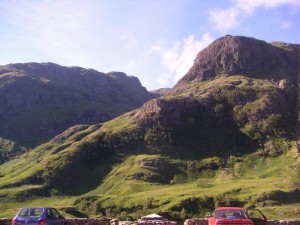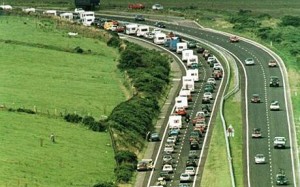In 2005, to mark the end of our school days, three friends and I travelled to John O’Groats and started out on our first big bike ride. We were bound for Land’s End, a mere 900 miles from where we stood at the most northern point of Scotland. Standing below the sign, I distinctly remember running over and over my concerns about cycling through the mountains of Scotland.

The mountain pass out of Glen Coe Village
The lengthy details of this ride are perhaps best saved for another day, but the point I wish to make, is that the Scottish mountains, although much higher than anything else we would scale on our South-bound journey, were relatively easy to climb. The terrain afforded us rest between ascents, long and peaceful descents and spectacular scenery to take all thoughts away from how mean the grade of the climb might have been.
The South West of England, however, remains in my mind as being extremely challenging, consisting of relentless rolling climbs which pan ahead for continuous viewing. On our first end-to-end, we utilised much of the A30 to accumulate our miles, thus sticking with the road from Exeter to Launceston, diverting through the narrower, quieter lanes, and re-joining the A30 just South of Bodmin where we continued until we reached Land’s End. Maybe it was the coupling of tiredness and the rolling hills, but I recall finding this the most challenging section of the whole end-to-end. Speaking to other riders who have completed the journey, there seems to be a general consensus that the South West offers some of the most difficult cycling.
I guess I had built up this image of the A30 in my mind as being a major barrier to the success of this event. Given that I am riding it, in it’s full length, in both directions, in just a matter of days, I was concerning myself that it could be my downfall; I was starting to get worried about it.
So I decided the best option was to go and ride it. I wanted to make sure that I was happy with it, from end to end. At the same time as being aware of all the long hills, I was also aware of how busy the road gets with heavy traffic and plenty of lorries. After all, it’s the main crossing from Devon into Cornwall. I set out at 0500 with my camelback full of food, and as much water as I could fit in my bottle cages. I joined the A38 (extremely quiet at that time of the morning) and headed along the route to Wellington. I then continued over the border into Devon, making some very good time getting there. The sun was already coming up, and I was benefitting from the warmth. I met one guy on his rusty steed just by the motorway services who asked where I was headed at this time of the morning. When I replied “Land’s End”, he said, in a very broad accent: “well weather’s meant to be fair for the next few days, so you should make it down there dry”.

The A30?!
I decided on this journey I was going to try an alternative option for accessing Exeter from Wellington. Rather than sticking with the old road, like I did last time, I opted for the longer route through Tiverton and Bickleigh, following the exe valley down into Exeter city. This proved a perfect decision and has since resulted in changes to the event route. We will now pass from Exeter, up exeter road, following the Exe valley back to Tiverton (clearly the same in reverse on the return). The surface was much, much better and this made the journey time shorter, although covering greater mileage.
Tom Emery had offered me breakfast in Exeter, had I been there at a reasonable time. I did, however, get a firm warning, that if his 7 o-clock alarm hadn’t sounded, I was not allowed to knock on the door! So, given that it still wasn’t 7am, I continued through the city and picked up the signs for Okehampton, knowing that this road would turn me out onto the A30. Until this point I had somehow averaged 24mph, the reason for me making good time, but I was pretty sure that my speed would drop dramatically once the A30 got a hold of me. Fortunately, traffic wasn’t quite as heavy as shown in the picture left, but remove the cars, and that is exactly what the A30 looks like…continuously.
As the day was maturing, more and more cars were appearing. I was settling into the routine of climbing, looking ahead to the next climb, descending merging into the next climb, and so on and so on. It took no time at all for me to get pretty bored mentally. I knew I wasn’t going to be turning off, or crossing any roundabouts, or stopping at any traffic lights (because I do that all the time!) for the best part of another 140 miles, so I was pretty lost for mental stimulation. I had exhausted both lines of the song stuck in my head, singing them in numerous voices, accents, rhythms and tunes (it’s wonderful how strange the thought processes when there is nothing else to do!), so I just got on with turning the pedals, thinking about how much more pleasant it would be with a bit of company. That is a pretty big hint for any South Westerners who want to come and ride the A30 too – you’re more than welcome.
With such a lack of stimulation it became very easy to simply think about the remaining miles which I had ahead of me. And sure enough, I soon started to think about how I had struggled before on some of the more major climbs. I also had this image of ‘the big dipper’ which several Cornish folk had warned me about. By the time I had reached 100 miles for the day, this ‘big dipper’ had grown in my mind, and I was working out where I’d get the climbing ropes from in order to scale it. Again, I was exaggerating everything about this section of the ride.
I started to function in 10 mile intervals. I knew I could ride 10 miles pretty well, I just needed to do it another 12 times and I would be there. This helped pass the distance, and stopped me focusing on the signs reading 60 / 70 / 80 miles. These were no good to me – they held no relevance. My computer told me every 10 miles and I was able to mark these times with food, or some extra drink.
I was happy with the traffic too. Despite some extensive road works, and some heavy traffic at times, I received not a single aggressive horn blow, no shouts out the windows, no drivers counting to two with the aid of their fingers – nothing but occasional cheers and encouragement. I think that is the first time I’ve experienced an open road ride like that!
I was pleasantly surprised with how I dealt with the A30. There were a few moments around Truro when I felt that I was beginning to tire and was feeling hungry, but I was making such good time, that I had to have been riding at a reasonable pace. In fact, I managed to get all the way down there in under 7 hours – something I certainly was not expecting. It did mean that I was over-joyed to get some ice-cream and a good old cornish pasty to devour. It would have been rude to have anything else while down at the very bottom, right?!
This ride taught me that the A30 isn’t the monster that I had remembered it to be. That’s not to say that I think it is a doddle… most certainly not. It will still be a particularly daunting section of the ride, particularly on the return, but I am relieved that I have been able to remove that major concern from my mind. Now I just have to worry about this bit,and that bit, and that other bit…..
I am sure everyone who has cycled can share my thought on this one: whenever I complete a big ride, one with huge, challenging climbs, climbs which at the time really burn, hurt, and seem to last forever, and even when the rain, the cold and the wind are making it so nasty, people ask how it was, or ‘did you have a good ride?’ and I always seem to reply with a yes?! The bad parts seem to be more easily forgotten, and the 30 second downhill memory remains in place of the ten minute stuggle to get to the top. That’s why we keep going back I guess.

